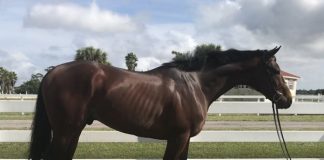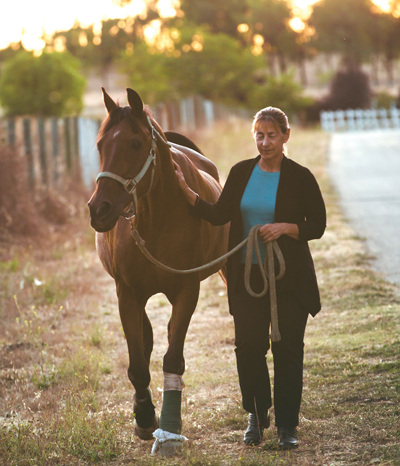
The day may come when it’s time to retire your senior horse from riding, perhaps due to arthritis or an old injury that would prevent you from being able to exercise him like before. Or perhaps he’s developed neurological issues and can’t safely carry anyone. Or he’s developed an allergy or breathing issue that would make riding painful or stressful. But just as with human seniors, our equine golden oldies still benefit from activity and movement to maintain muscle tone and flexibility and a level of fitness. While most of us may not be up for running a marathon when we’re 75, we’ll likely benefit from walking, a little dancing, tai chi, yoga, and light weight training.
“In many ways, designing an exercise program for an unrideable senior horse can mimic how we work with a horse that’s too young to be ridden,” says Mero. The primary difference is that the senior has decades of life experience and usually a foundation of training.
Instead of training a lot of new concepts, you’ll focus on maintaining overall fitness, but with a caveat.“I’m not advocating working a horse that’s very arthritic, in pain or lame,” says Mero. “To me, that’s cruel. This program is for horses who are otherwise sound but can’t be ridden for some reason.”
Turnout Time
The ideal solution for an unrideable horse is what nature intended: turnout.
“Having a senior horse on full-time turnout in a pasture or large area will provide the exercise he needs,” says Mero. “It’s especially important for horses with mild arthritis.”
Being able to move around for hours a day, preferably in the company of a herd with similar temperaments, promotes gentle fitness and helps a senior horse maintain muscle tone and interest in his surroundings.
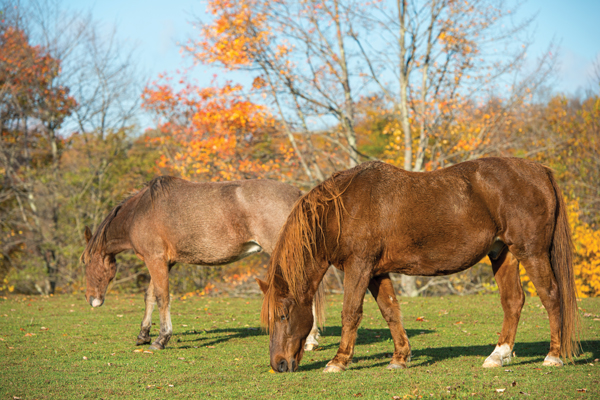
But in reality, maybe your horse is boarded at a facility where he’s in a stall or pen with a run. Or he requires a special diet that means he has to be separated from other horses. Perhaps you’ve tried keeping him on pasture with a herd, but he was pushed away from the hay or he’s being bullied by younger and more dominant herd members.
In these situations, your horse will likely do better in an individual pen and will rely on you for adequate exercise.
“For horses who live in smaller pens, I highly recommend daily turnout in a large area and preferably with a companion or two,” says Mero. “This helps them get gentle exercise and have social time with other horses.”
One solution is to work with owners of other senior horses where you board and coordinate turnout times so your horses can go out together.
In-Hand Work
There are still in-hand exercises that a retiree can do, but don’t forget to consult with your veterinarian to ensure there aren’t any health issues that could cause pain or discomfort.
“Working your horse over ground poles or cavalletti increases his neuroplasticity and proprioception—his ability to know where his body is in space,” says Mero.
Set up patterns of ground poles or 8-foot lengths of sturdy PVC pipe; elevate some of the poles so your horse will need to lift his feet higher. You can walk your horse over and around the poles, ask him to back up through two parallel poles or in an “L” pattern, or make a circle inside a frame of poles. Get creative!
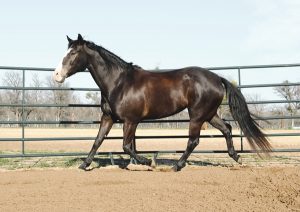
Light longeing or round pen work for 15 to 20 minutes is good for cardio fitness.
“But remember the young horse approach when working on a small circle,” says Mero. “Running in a small pen or in deep sand can cause stress on the horse’s joints.”
Instead, use the session to work quietly and practice voice commands or responses to your body language.
Walking, Hiking and Ponying
“A lot of my clients with older horses go on walks and hikes together,” says Mero. “They both enjoy the scenery and each other’s company, and it keeps both horse and human fit.”
She adds that ponying your senior horse is a good alternative to hand-walking.
“Just be sure that the horse being ridden can go at a pace that’s comfortable for the senior, who may need to walk more slowly and for shorter distances than a younger horse,” she adds.
Aim for walks at least three to four times a week; a daily walk is even better.
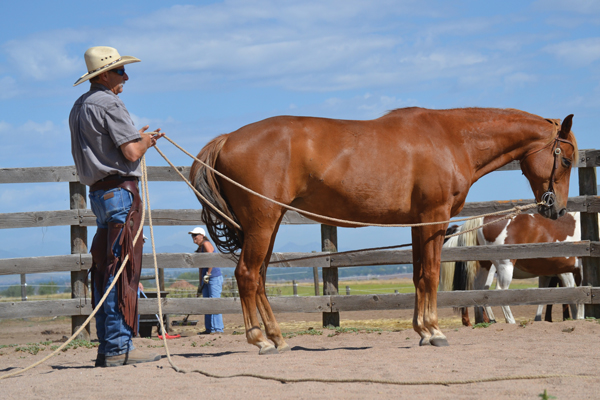
Long-Lining or Harness Work
Working your horse from the ground in two reins can provide exercise and mental stimulation—for both of you.
“You don’t need a full harness, or even a cart,” says Mero.
Start with two long lines or a pair of driving reins, attaching each rein to the side ring of the halter, and start in a pen or arena. Walk slightly to the inside of the circle, and guide your horse as you would from the saddle. Navigate around poles or cones to give more context for turning.
“Once you’re comfortable in the enclosed area, and you can turn, change directions, and stop, head outside for a long-line walk on trails or quiet roads,” she says.
If you both really enjoy the long-lining work, think about learning how to drive. Find an experienced trainer with the equipment who can teach you.
Games and Trick Training
You actually can teach an older horse new tricks, and trick training can give you both something fun to learn. Find a book or video with simple tricks, like picking up a hat or rolling a large ball, and go from there.
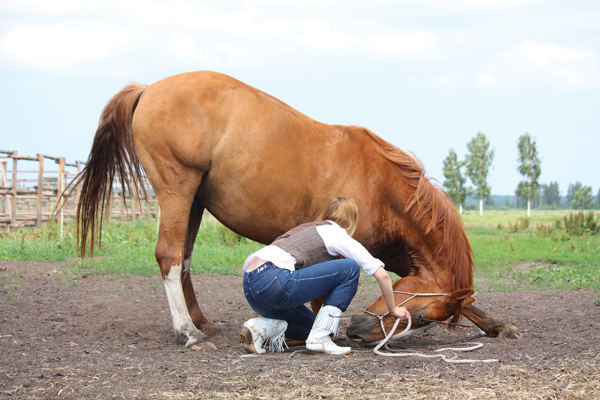
Trick training provides movement as well as mental stimulation. Just be sure to not overtrain or drill, and keep it fun. And remember that some tricks, such as teaching a horse to paw or rear, may appear when you don’t necessarily want them to.
Just Be Together
“Senior horses can be a lot like older people,” says Mero. “While they may have been successful competitors or working horses, now they may prefer a life of quiet companionship with horses and their person.”
Now you can enjoy time with no agenda other than being together. Taking long walks together, going for groom-and-graze sessions where you brush him a bit as he’s grazing, or just hanging out in the pasture or turnout while your horse moseys around can bring you both happiness.
Adding Light to Golden Years
Just because your senior horse can’t be ridden, there are many ways to help keep him fit and vibrant.
There’s one more added benefit of walks, hikes, ground driving and other gentle exercises: You both stay younger and more agile, and the bond you’ve shared over the years gets even stronger.
This article about how to exercise a senior horse appeared in the October 2020 issue of Horse Illustrated magazine. Click here to subscribe!





